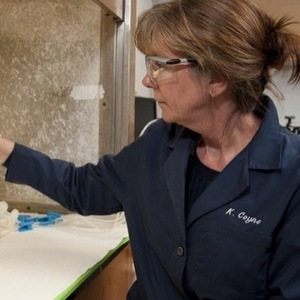Del. professor examines Heterosigma akashiwo algae for biofuels

Photo: Kathy F. Atkinson
June 27, 2013
BY Teresa Messmore, University of Delaware
A hardy algae species is showing promise in both reducing power plant pollution and making biofuel, based on new research at the University of Delaware.
The microscopic algae Heterosigma akashiwo grows rapidly on a gas mixture that has the same carbon dioxide and nitric oxide content as emissions released from a power plant.
“The algae thrive on the gas,” said Kathryn Coyne, associate professor of marine biosciences in UD’s College of Earth, Ocean, and Environment. “They grow twice as fast and the cells are much larger in size compared to when growing without gas treatment.”
The algae also make large amounts of carbohydrates, which can be converted into bioethanol to fuel vehicles. The findings could have industrial applications as a cost-effective way to cut greenhouse gas pollution when paired with biofuel production.
Heterosigma akashiwo is found worldwide in the natural environment. Coyne, an expert in algal blooms, discovered that the species may have a special ability to neutralize nitric oxide—a harmful gas that poses threats to environmental and human health.
Advertisement
That characteristic prompted Coyne and her team to investigate whether the algae could grow on carbon dioxide without getting killed off by the high nitric oxide content in power plants’ flue gas, which had foiled similar attempts by other scientists using different types of algae.
A yearlong laboratory experiment shows that Heterosigma akashiwo not only tolerates flue gas, but flourishes in its presence. The algae also do not need any additional nitrogen sources beyond nitric oxide to grow, which could reduce costs for raising algae for biofuel production.
“This alone could save up to 45 percent of the required energy input to grow algae for biofuels,” Coyne said.
Funded by the Delaware Sea Grant College Program, Coyne and her collaborator, Jennifer Stewart, plan to further study how changes in conditions can enhance the growth of Heterosigma akashiwo. So far, they found a large increase in carbohydrates when grown on flue gas compared to air. They also see correlations between the levels of light given to the algae and the quantity of carbohydrates and lipids present in the organisms.
The researchers are exploring opportunities for partnerships with companies to scale up the growth process and more closely examine Heterosigma akashiwo as a biofuel producer.
Advertisement
The prospects could support a national focus on carbon pollution reduction following President Barack Obama’s major speech this week on climate change.
“Our approach to the issue is to not just produce biofuels, but to also use this species for bioremediation of industrial flue gas to reduce harmful effects even further,” Coyne said.
To learn more about this project, visit the Delaware Sea Grant website.
The University of Delaware was designated as the nation’s ninth Sea Grant College in 1976 to promote the wise use, conservation and management of marine and coastal resources through high-quality research, education and outreach activities that benefit the public and the environment.
UD’s College of Earth, Ocean, and Environment administers the program, which conducts research in priority areas ranging from seafood safety to coastal hazards.
Related Stories
A notice published in the Federal Register by the U.S. EPA indicates that far fewer parties than originally anticipated have registered with the agency as biointermediate producers under the Renewable Fuel Standard.
With exclusive licensing to a camelina seed variety, Ash Creek Renewables is breaking down barriers to a renewable future.
The USDA reduced its estimate for 2024-’25 soybean use in biofuel production in its latest WASDE report, released May 12. The agency expects soybean oil use in biofuel to increase during the 2025-’26 marketing year.
HutanBio's microalgal biofuel production shown to be net-negative in an independent life cycle assessment by EcoAct
HutanBio on May 8 announced that the production process for its proprietary HBx microalgal biofuel achieves net-negative carbon emissions, based on an independent cradle-to-gate life cycle assessment (LCA) conducted by EcoAct.
According to a new economic contribution study released by the Iowa Renewable Fuels Association on May 6, Iowa biofuels production has begun to reflect stagnant corn demand throughout the agriculture economy.
Upcoming Events










